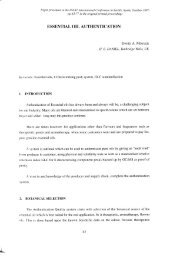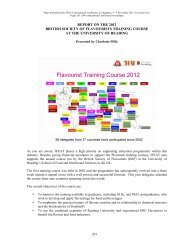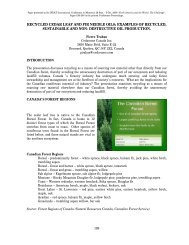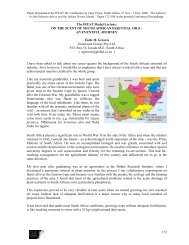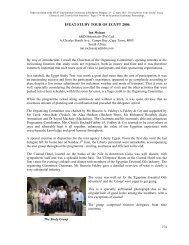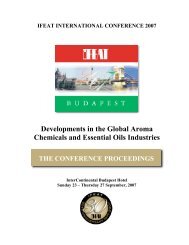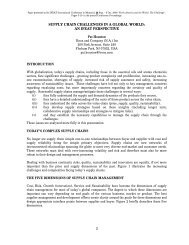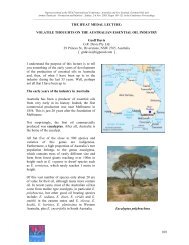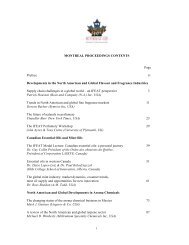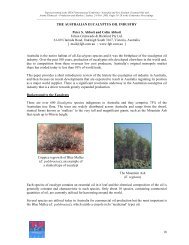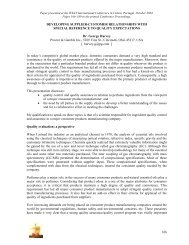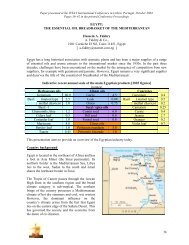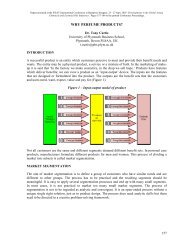Paper presented at the IFEAT Int. Conference in Cape Town
Paper presented at the IFEAT Int. Conference in Cape Town
Paper presented at the IFEAT Int. Conference in Cape Town
Create successful ePaper yourself
Turn your PDF publications into a flip-book with our unique Google optimized e-Paper software.
A. betul<strong>in</strong>a x crenul<strong>at</strong>a essential oils tend to show a lot of vari<strong>at</strong>ion <strong>in</strong> <strong>the</strong>ir chemical compositions,presumably due to <strong>the</strong> degree of hybridiz<strong>at</strong>ion and/or <strong>the</strong> chemotype of A. betul<strong>in</strong>a genetic m<strong>at</strong>erialth<strong>at</strong> was <strong>in</strong>volved <strong>in</strong> <strong>the</strong> cross<strong>in</strong>g. These oils are never<strong>the</strong>less generally characterized by GC (FID) ashav<strong>in</strong>g a medium limonene level (15-25%), vary<strong>in</strong>g concentr<strong>at</strong>ions of menthone/isomenthone (0-20%), with correspond<strong>in</strong>gly <strong>in</strong>versely vary<strong>in</strong>g diosphenol (Ψ-diosphenol and diosphenol comb<strong>in</strong>ed)concentr<strong>at</strong>ions (0-20%), medium to high pulegone concentr<strong>at</strong>ions (15-40%), vary<strong>in</strong>g amounts ofcis/trans-8-mercapto-p-menthan-3-one isomers (<strong>in</strong> a 1:4 to 3:4 trans:cis isomer r<strong>at</strong>io, but always moretrans than cis isomers present) and vary<strong>in</strong>g amounts of cis/trans-8-acetylthio-p-menthan-3-oneisomers (0.1-2%, <strong>in</strong> <strong>the</strong> same 8:1 trans:cis isomer r<strong>at</strong>io found <strong>in</strong> A. crenul<strong>at</strong>a oil).GC trace of <strong>the</strong> essential oil of A. betul<strong>in</strong>a x crenul<strong>at</strong>a (typical)Although <strong>the</strong> identity of each of <strong>the</strong> compounds found <strong>in</strong> buchu oils has been known s<strong>in</strong>ce 1975 [4] , itwas not until 1996 th<strong>at</strong> <strong>the</strong> exact chemotaxonomy of <strong>the</strong> various buchu oils was described [3] . Until<strong>the</strong>n <strong>the</strong> chemical composition of a general ‘buchu oil’, which could chemically look like any of <strong>the</strong>oils described above (or any mixture of <strong>the</strong>m), was gre<strong>at</strong>ly dependant on <strong>the</strong> <strong>in</strong>itial historicalagricultural source of <strong>the</strong> oil. In th<strong>at</strong> <strong>the</strong> unique olfactory properties of each <strong>in</strong>dividual type of buchuoil was never formally described, due to <strong>the</strong> failure of buchu oil distillers to recognize or haveknowledge of <strong>the</strong> various types of buchu oils available, <strong>the</strong> use of each type of buchu oil forspecialized applic<strong>at</strong>ions is poorly developed, <strong>the</strong>reby limit<strong>in</strong>g <strong>the</strong> use of buchu oil to fewerapplic<strong>at</strong>ions than <strong>the</strong>ir potential.Oils from specific species / chemotypes or blends of species / chemotypes may <strong>in</strong>deed have a desiredeffect <strong>in</strong> specific applic<strong>at</strong>ions. Fur<strong>the</strong>rmore, <strong>in</strong>consistencies <strong>in</strong> chemical compositions, and <strong>the</strong>reforealso olfactory characteristics, of general ‘buchu oils’, as a result of <strong>the</strong> vari<strong>at</strong>ions <strong>in</strong> oils and <strong>the</strong>historical <strong>in</strong>ability to accur<strong>at</strong>ely determ<strong>in</strong>e and control any such vari<strong>at</strong>ions, have certa<strong>in</strong>ly also brandedbuchu oil as a raw m<strong>at</strong>erial of <strong>in</strong>consistent quality <strong>in</strong> <strong>the</strong> past. Large scale harvest<strong>in</strong>g / poach<strong>in</strong>g ofbuchu from wild sources, where many uncontrollable factors (e.g. wild fires, droughts, pests etc.)come to play, fur<strong>the</strong>rmore, made <strong>the</strong> availability of buchu plant m<strong>at</strong>erial <strong>in</strong>consistent, to say <strong>the</strong> least.When comb<strong>in</strong><strong>in</strong>g variablility of supply with gre<strong>at</strong> vari<strong>at</strong>ions <strong>in</strong> composition / quality, it becomesobvious why buchu oil rema<strong>in</strong>ed a niche product <strong>in</strong> <strong>the</strong> flavour and fragrance <strong>in</strong>dustry for such a long104



